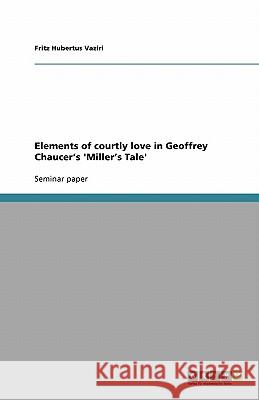Elements of courtly love in Geoffrey Chaucer's 'Miller's Tale' » książka
Elements of courtly love in Geoffrey Chaucer's 'Miller's Tale'
ISBN-13: 9783640138708 / Angielski / Miękka / 2008 / 36 str.
Seminar paper from the year 2007 in the subject English Language and Literature Studies - Literature, grade: 1,0, Free University of Berlin (Institut fur Englische Philologie), course: Geoffrey Chaucer's Canterbury Tales, 15 entries in the bibliography, language: English, abstract: When approaching an investigation on the elements of courtly love in a piece of literature as for instance Geoffrey Chaucer's Miller's Tale, it seems more than reasonable to first of all clarify what the term actually means, i.e. what the focus of study is to be. Consequently, such a clarification constitutes the beginning and also the basis of the examination developed in the course of this paper. It might not be a clarification, however, but at least to a certain extent rather an illustration of the scholarly controversy connected with amour courtois and its English equivalent. Still, ample characteristics of the concept behind the term will be found which are suited to be analyzed in the light of their application in the Miller's Tale. A preceding brief observation of Chaucer's Knight's Tale in the context of this issue is inserted for the purpose of gaining a more differentiated view onto the appearance of elements of courtly love in the second of the Canterbury Tales. A final conclusion will sum up central findings. Since its introduction in the nineteenth century a lot of controversy has surrounded the term amour courtois, as far as its use and necessity are concerned. What are the reasons for such difficulties in finding consent here and what are the various connotations involved in the idea of courtly love? It is by no means possible to thoroughly illustrate all conflicting positions in detail on the following pages, but some significant arguments will be outlined hereafter. A brief look at the development of the notion of courtly love might be helpful in reaching a better understanding of the issue at hand. Where does the term actually come from? When was it developed and by wh"











